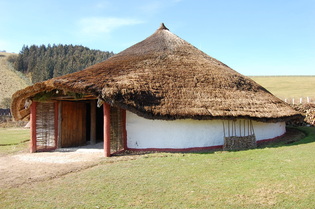
The Little Woodbury roundhouse, Butser Ancient Farm.
Just before the outbreak of the Second World War, Gerhard Bersu, a German archaeologist who fled the Nazis and came to Britain, undertook excavations at Little Woodbury near Salisbury in Wiltshire, a site identified through aerial photography. Up to this point it was commonly believed that the people of this period lived in simple shelters called 'pit dwellings', little more than a tent erected over a hollow. Bersu opened a large area and noted two concentric rings of post-holes that formed a 15m enclosure that he postulated were the remains of an Iron Age house.
Butser Ancient Farm is a purpose built archaeological research centre founded by the Council of British Archaeology in 1970 and run for many years by Peter Reynolds. His work, along with David Freeman among others, has been fundamental in enhancing our understanding of Iron Age archaeology, and consequently Iron Age life.
The Little Woodbury roundhouse was substantial and contained four central posts within the main post-ring. These, according to some, could have supported a mezzanine floor, and two large holes in the ground found within the roundhouse could have been footings for a staircase. For this to work the roof would have needed to have been at a steeper angle than as seen on this reconstruction, in order to provide a usable space.
Just before the outbreak of the Second World War, Gerhard Bersu, a German archaeologist who fled the Nazis and came to Britain, undertook excavations at Little Woodbury near Salisbury in Wiltshire, a site identified through aerial photography. Up to this point it was commonly believed that the people of this period lived in simple shelters called 'pit dwellings', little more than a tent erected over a hollow. Bersu opened a large area and noted two concentric rings of post-holes that formed a 15m enclosure that he postulated were the remains of an Iron Age house.
Butser Ancient Farm is a purpose built archaeological research centre founded by the Council of British Archaeology in 1970 and run for many years by Peter Reynolds. His work, along with David Freeman among others, has been fundamental in enhancing our understanding of Iron Age archaeology, and consequently Iron Age life.
The Little Woodbury roundhouse was substantial and contained four central posts within the main post-ring. These, according to some, could have supported a mezzanine floor, and two large holes in the ground found within the roundhouse could have been footings for a staircase. For this to work the roof would have needed to have been at a steeper angle than as seen on this reconstruction, in order to provide a usable space.
 RSS Feed
RSS Feed